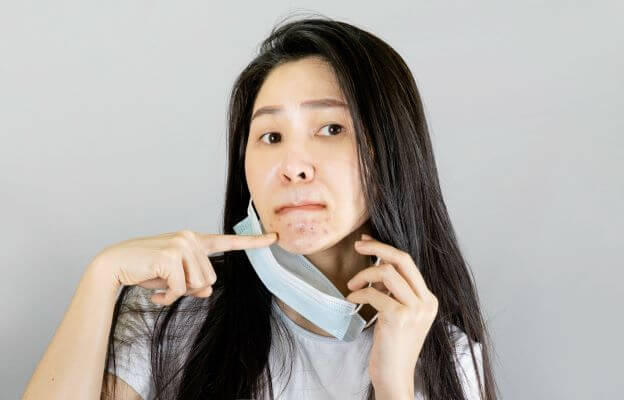There have been a lot of surprising consequences of the coronavirus (COVID-19) pandemic, but for dermatologists, one of the main side effects of the pandemic that they are seeing is an increase in perioral dermatitis. According to Dr. Jennifer Holman of U.S. Dermatology Partners in Tyler, Texas, “Increased emotional stress and mask wear by front-line workers and the general population means that more people are experiencing rashes around the mouth, which we call perioral dermatitis. Luckily, there are some good options for preventing and treating this condition, and we’re here to help.” In this blog, Dr. Holman explains what perioral dermatitis is, how it happens, and how you can prevent this itchy, irritating condition while maintaining proper safety protocols.
What is Perioral Dermatitis?
You’ll find the definition of perioral dermatitis in its name. This condition is a skin rash or irritation (dermatitis) that appears around (peri) the mouth (oral). According to Dr. Holman, “It can be very uncomfortable for the patient and some cases look serious, but for the most part, it’s just an irritating skin condition. It’s not contagious and it doesn’t usually cause serious adverse health effects. With proper care, most people start feeling better quickly, but it can take a while for the condition to clear up completely.” Even with treatment, it can take weeks for perioral dermatitis to completely clear up, so it’s important to start treating the condition as soon as you see the first warning signs.
What are the Symptoms of Perioral Dermatitis?
Perioral dermatitis creates a rash around the mouth. In most cases, the rash is located just around the mouth, but it can spread around the nose and even the eyes. According to Dr. Holman, “When it’s caused by mask wear, we are, unsurprisingly, seeing the rashes in the shape of the face mask. So, around the mouth, the nose, on the chin, and even around the ears in some cases, but the upper part of the face is mostly unaffected.” The lips and nostrils and the skin immediately surrounding these areas will typically not be affected by perioral dermatitis, and this can leave these areas looking paler than the rest of the face. Additionally, perioral dermatitis, even when caused by mask wear, will rarely develop on the cheeks.
The appearance of perioral dermatitis rashes will vary based on skin tone. In people with light skin tones, the rash is usually red or pink-colored and may look like acne. People with darker skin tones may see bumps that are close to their skin tone or slightly lighter or darker.
In addition to these noticeable bumps, symptoms of perioral dermatitis include:
- Itching, burning, and skin irritation and inflammation
- The affected area may feel numb or tingly
- The skin around the rash may be dry or flaky
- Bumps may develop into pustules that contain fluid and can resemble acne or small blisters
What Causes Perioral Dermatitis?
There’s no one specific underlying cause of perioral dermatitis. Factors like emotional stress, lack of sleep and a diet high in inflammatory foods such as sugar, trans fats, and refined carbohydrates are known to exacerbate the condition. Some other common factors that are related to the development of this condition include:
- Irritation – like wearing a face mask that rubs your skin all day and traps moisture against your face.
- Chemicals – a new skincare, cosmetic, or cleaning product can trigger a response. Using a new toothpaste is actually a common cause of perioral dermatitis, so don’t forget your oral hygiene products.
- Allergens – whether it’s from food, the environment (pollen), or other sources (your pets), an allergic reaction may result in a facial rash.
- Weather – very hot or cold, dry or humid, or other extreme weather conditions can cause a perioral dermatitis eruption.
- Medications – topical corticosteroids and steroid inhalers, especially used frequently or for an extended time, can lead to a face rash. Other topical and oral medications (prescription and over the counter) have also been linked to perioral dermatitis, including oral contraceptives, so pay attention whenever you begin taking a new medication.
- Poor hygiene – failure to keep skin clean and moisturized can lead to the development of perioral dermatitis.
- Systemic changes – hormonal shifts, immune system strain, and other changes in the body’s function can lead to a facial rash.
Why Does Wearing a Mask Worsen Perioral Dermatitis?
If you’ve been wearing a face mask when interacting with people and going out in public, you will likely have a pretty good idea of how mask wear can exacerbate perioral dermatitis. With a mask in place, your skin is warm, damp, and being irritated where the mask fabric rubs. Over time, this can contribute to or worsen perioral dermatitis. This has been especially problematic for those whose jobs require them to wear face masks for the entire day or several hours at a time.
Can I Prevent Mask-Related Perioral Dermatitis?
There are some steps you can take to avoid mask-related perioral dermatitis, including:
- Use very gentle facial cleansers with minimal ingredients.
- Discontinue the use of any exfoliants as part of your daily skincare routine.
- Use a good facial moisturizer after washing skin, before putting on your mask, and at night before you go to sleep.
- If you notice irritation, apply a protective product like petrolatum (petroleum jelly) to the affected area. This creates a protective barrier over your skin and improves moisture.
- If you use topical or inhaled steroids, be very careful. Steroids are a common trigger associated with perioral dermatitis, so you may need to minimize usage if you’re at risk for this skin condition. If you use a steroid inhaler, do your best to avoid getting the steroid mist on your skin. If you do, wash your face.
- Skip the makeup routine. We know you still want to look your best even with a face mask in place, but cosmetics can cause unnecessary irritation.
- Minimize sun exposure and make sure to apply sunscreen daily, especially if you’ll be outdoors for an extended time.
- Wash your sheets and pillowcase regularly using mild, hypoallergenic laundry detergent.
How do I Treat Perioral Dermatitis?
According to Dr. Holman, “Even if you do your best to prevent it, you may still develop perioral dermatitis from frequent mask wear. When that happens, your dermatologist can help you get the symptoms under control and work toward healing your skin. People often get frustrated by how long the rash can linger, but with consistent treatment, it will clear up.” Some of the recommended treatments include:
- Stop using topical corticosteroids, including over the counter hydrocortisone cream, on your skin. If another physician has prescribed corticosteroids, you may need to work with your doctor and dermatologist to find an alternative. When you first stop using your steroid cream, the itch and discomfort will likely get worse, but don’t resume corticosteroid use as this will only lead to further long term discomfort.
- In some cases, we will prescribe an antibiotic, especially if pustules develop. Additionally, topical antibacterial creams may be recommended for faster relief from itch and discomfort.
- Review all skincare, hygiene, cosmetic, and cleaning products you’re using with your dermatologist. Create a good skincare routine that will minimize irritation. We may also ask that you change your oral hygiene routine as certain toothpastes can be a contributor to perioral dermatitis.
- In some cases, immunosuppressive creams and/or topical rosacea medications are prescribed.
When Should I Visit a Dermatologist?
It can take a few weeks, but if your condition does not begin to clear up on its own when you discontinue corticosteroid use and switch to gentler hygiene practices, you may want to call your dermatologist. In some cases, this condition can develop into more serious skin health issues without proper care. Granulomatous perioral dermatitis and steroid-induced rosacea are two examples of how this condition can develop. Granulomatous perioral dermatitis often occurs in kids, and it is almost always caused by corticosteroid use. Steroid-induced rosacea can occur when perioral dermatitis develops into the pus-filled papules. These papules make patients much more likely to develop a response on their cheeks and forehead, which is characteristic of rosacea. Whether your condition isn’t clearing, it develops into a more severe case, or you’re just very uncomfortable, a trip to the dermatologist can help.
Visit U.S. Dermatology Partners
Our offices have reopened for non-emergency patients, so if you would like to visit us for perioral dermatology treatment, you can use our simple online request form to get started. Once we receive your information, a member of our team will be in touch.
Additionally, we are still happy to offer online virtual appointments for patients who need to maintain stricter social distancing measures. You can complete our teledermatology session request form or call your local office to get started.
Find a location near me
or


